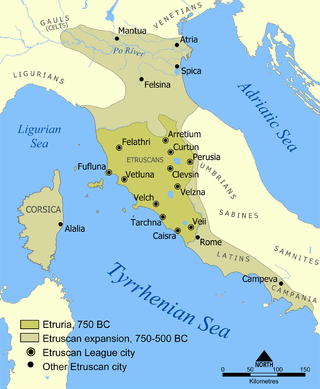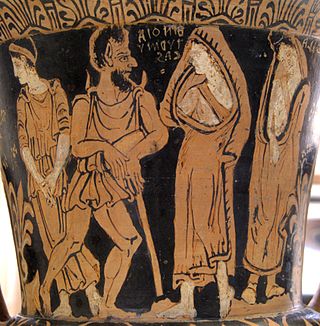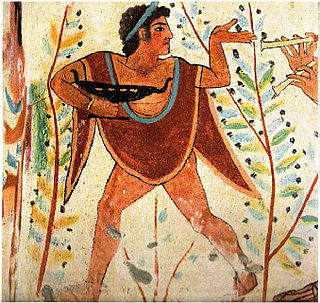Related Research Articles

Etruscan was the language of the Etruscan civilization in the ancient region of Etruria and its colonies in what is now Italy. Etruscan influenced Latin but was eventually completely superseded by it. The Etruscans left around 13,000 inscriptions that have been found so far, only a small minority of which are of significant length; some bilingual inscriptions with texts also in Latin, Greek, or Phoenician; and a few dozen purported loanwords. Attested from 700 BC to AD 50, the relation of Etruscan to other languages has been a source of long-running speculation and study, with its being referred to at times as an isolate, one of the Tyrsenian languages, and a number of other less well-known theories.

The Etruscan civilization was developed by a people of Etruria in ancient Italy with a common language and culture who formed a federation of city-states. After conquering adjacent lands, its territory covered, at its greatest extent, roughly what is now Tuscany, western Umbria, and northern Lazio, as well as what are now the Po Valley, Emilia-Romagna, south-eastern Lombardy, southern Veneto, and western Campania.
The Old Italic scripts are a family of similar ancient writing systems used in the Italian Peninsula between about 700 and 100 BC, for various languages spoken in that time and place. The most notable member is the Etruscan alphabet, which was the immediate ancestor of the Latin alphabet currently used by English and many other languages of the world. The runic alphabets used in northern Europe are believed to have been separately derived from one of these alphabets by the 2nd century AD.

Etruria was a region of Central Italy delimited by the rivers Arno and Tiber, an area that covered what is now most of Tuscany, northern Lazio, and north-western Umbria.

Etruscan religion comprises a set of stories, beliefs, and religious practices of the Etruscan civilization, heavily influenced by the mythology of ancient Greece, and sharing similarities with concurrent Roman mythology and religion. As the Etruscan civilization was gradually assimilated into the Roman Republic from the 4th century BC, the Etruscan religion and mythology were partially incorporated into ancient Roman culture, following the Roman tendency to absorb some of the local gods and customs of conquered lands. The first attestations of an Etruscan religion can be traced back to the Villanovan culture.

In Etruscan mythology, Charun acted as one of the psychopompoi of the underworld. He is often portrayed with Vanth, a winged figure also associated with the underworld.
In Etruscan religion, Fufluns or Puphluns was a god of plant life, happiness, wine, health, and growth in all things. He is mentioned twice among the gods listed in the inscriptions of the Liver of Piacenza, being listed among the 16 gods that rule the Etruscan astrological houses. He is the 9th of those 16 gods. He is the son of Semla and the god Tinia. He was worshipped at Populonia and is the namesake of that town.

Menrva was an Etruscan goddess of war, art, wisdom, and medicine. She contributed much of her character to the Roman Minerva. She was the child of Uni and Tinia.
In Etruscan mythology, Tarchon and his brother, Tyrrhenus, were culture heroes who founded the Etruscan League of twelve cities, the Dodecapoli. One author, Joannes Laurentius Lydus, distinguishes two legendary persons named Tarchon, the Younger and his father, the Elder. It was the Elder who received the Etrusca Disciplina from Tages, whom he identifies as a parable. The Younger fought with Aeneas after his arrival in Italy. The elder was a haruspex, who learned his art from Tyrrhenus, and was probably the founder of Tarquinia and the Etruscan League. Lydus does not state that, but the connection was being made at least as long ago as George Dennis. Lydus had the advantage in credibility, even though late, of stating that he read the part of the Etrusca Disciplina about Tages and that it was a dialogue with Tarchon's lines in "the ordinary language of the Italians" and Tages' lines in Etruscan, which was difficult for him to read. He relied on translations.

In Etruscan religion and mythology, Tinia was the god of the sky and the highest god in Etruscan mythology, equivalent to the Roman Jupiter and the Greek Zeus. However, a primary source from the Roman Varro states that Veltha, not Tins, was the supreme deity of the Etruscans. This has led some scholars to conclude that they were assimilated, but this is speculation. He was the husband of Uni and the father of Hercle. Like many other Etruscan deities, his name is gender neutral.

Giuliano Bonfante was an Italian linguist and expert on the language of the Etruscans and other Italic peoples. He was professor of linguistics at the University of Genoa and then at the University of Turin.

The Apollo of Veii is a life-size painted terracotta Etruscan statue of Aplu (Apollo), designed to be placed at the highest part of a temple. The statue was discovered in the Portonaccio sanctuary of ancient Veii, Latium, in what is now central Italy, and dates from c. 510 - 500 BC. It was created in the so-called "international" Ionic or late-archaic Etruscan style.

Etruscan society is mainly known through the memorial and achievemental inscriptions on monuments of Etruscan civilization, especially tombs. This information emphasizes family data. Some contractual information is also available from various sources. The Roman and Greek historians had more to say of Etruscan government.

Etruscan cities were a group of ancient settlements that shared a common Etruscan language and culture, even though they were independent city-states. They flourished over a large part of the northern half of Italy starting from the Iron Age, and in some cases reached a substantial level of wealth and power. They were eventually assimilated first by Italics in the south, then by Celts in the north and finally in Etruria itself by the growing Roman Republic.
Larissa Bonfante was an Italian-American classicist, Professor of Classics emerita at New York University and an authority on Etruscan language and culture.

Usil is the Etruscan god of the sun, later nicknamed Apulu (Apollo). His iconic depiction features Usil rising out of the sea, with a fireball in either outstretched hand, on an engraved Etruscan bronze mirror in late Archaic style, formerly on the Roman antiquities market. On Etruscan mirrors in Classical style, Usil appears with a halo.
Vegoia is a sibyl, prophet, or nymph within the Etruscan religious framework who is identified as the author of parts of their large and complex set of sacred books, detailing the religiously correct methods of founding cities and shrines, draining fields, formulating laws and ordinances, measuring space and dividing time; she initiated the Etruscan people to the arts, as originating the rules and rituals of land marking, and as presiding over the observance, respect, and preservation of boundaries. Vegoia also is known as Vecu, Vecui, and Vecuvia, as well as Vegoe; her name is also given as Begoe or Bigois.

Satre or Satres was an Etruscan god who appears on the Liver of Piacenza, a bronze model used for haruspicy. He occupies the dark and negative northwest region, and seems to be a "frightening and dangerous god who hurls his lightning from his abode deep in the earth." It is possible that Satre is also referred to with the word "satrs" in the Liber Linteus, the Etruscan text preserved in Ptolemaic Egypt as mummy wrappings.

Culsans (Culśanś) is an Etruscan deity, known from four inscriptions and a variety of iconographical material which includes coins, statuettes, and a sarcophagus. Culśanś is usually rendered as a male deity with two faces and at least two statuettes depicting him have been found in close association with city gates. These characteristics suggest that he was a protector of gateways, who could zealously watch over the gate with not one, but two pairs of eyes.
References
- Bonfante, Giuliano; Bonfante, Larissa (2002). The Etruscan Language: an Introduction. Manchester: University of Manchester Press. ISBN 0-7190-5540-7. Preview available on Google Books.
- De Grummond; Nancy Thomson (2006). Etruscan Mythology, Sacred History and Legend: An Introduction. University of Pennsylvania Museum of Archaeology. ISBN 1-931707-86-3. Preview available on Google Books.
- Dennis, George (1848). The Cities and Cemeteries of Etruria. London: John Murray. Available in the Gazetteer of Bill Thayer's Website at
- Leland, Charles Godfrey (1892). Etruscan Roman Remains in Popular Tradition. London: T. Fisher Unwin. Downloadable Google Books, online at .
- Pallottino, M. (1975). The Etruscans. London: Penguin Books.
- Richardson, Emeline Hill (1976) [1964]. The Etruscans: Their Art and Civilization . Chicago: University of Chicago Press. ISBN 0-226-71234-6.
- Swaddling, Judith & Bonfante, Larissa (2006). Etruscan Myths. University of Texas Press. ISBN 0-292-70606-5. Preview Google Books.
- Thulin, Carl (1906). Die Götter des Martianus Capella und der Bronzeleber von Piacenza. Alfred Töpelmann. A German-language book, downloadable from Google Books.
